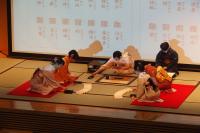The Essence of the Palace "Kyutei-no-Hana", The Tale of Genji (2014)
- TOP
- Traditional Research of The Tale of Genji
- The Essence of the Palace "Kyutei-no-Hana", The Tale of Genji (2014)
As part of the events commemorating the completion of phase-1 of the Shibuya Campus Construction Plan, an exhibition, symposium and lecture were held on the theme of The Essence of the Palace "Kyutei-no-Hana" at the Shibuya Campus lasting four days from June 7 (Saturday) to 10 (Tuesday).
<Exhibition - The Essence of the Palace "Kyutei-no-Hana">
Dates and Times: June 7 (Saturday) to 10 (Tuesday), 2014
10:00 to 17:00 (10:00 to 16:00 on the final day)
Venues: Jissen Women's University Junior College
120th Anniversary Building of the Shibuya Campus,
<Symposium - The Tale of Genji and Fragments of Ancient Calligraphy>
Dates and Times: June 7 (Saturday), 2014
13:00 to 17:00
Venues: Jissen Women's University Junior College
120th Anniversary Building of the Shibuya Campus, in Classroom 403 on the 4th floor
<Lecture - The Fragrances and Attire of the Court>
Dates and Times: June 8 (Sunday), 2014
13:00 to 15:30
Venue: Jissen Gakuen Junior & Senior High School
Toyokan Hall, Sakura Auditorium
Event Report
ExhibitionThe Essence of the Palace "Kyutei-no-Hana", The Tale of Genji

1,145 visitors came to the exhibition that took place in the presentation room of the “120th Anniversary Building” and the Kosetsu Memorial Hall in the new University Junior College Building for four days from June 7 (Saturday) to 10 (Tuesday).
In addition to fragments of ancient calligraphy of “The Tale of Genji” from the Middle of the Kamakura Period to the early Muromachi Period owned by the university, exhibits included various items deeply related to “The Tale of Genji” such as an incense box said to have been a treasured item belonging to Empress Teimei, wife of Emperor Taisho, as well as other incense implements, a twelve-layered ceremonial kimono (one-quarter life size) and balls used in Kemari, a type of football played by courtiers in ancient Japan, materials associated with Mitoko Sakayori, who assisted the university’s founder, Utako Shimoda, such as a yukatabira, or single-layered absorbent bathrobe worn by Empress Dowager Shoken and other sundry bestowals and certificates of graduation from aristocratic schools for women.
In addition, the exhibition included "Yoru no Nezame (Wakefulness at Midnight),” a full-length work of dynastic literature from the late Heian Period taht is believed to be a fragment of the lost part of a copy of The Tale of Genji.
SymposiumThe Tale of Genji and Fragments of Ancient Calligraphy

At the symposium held on June 7 (Saturday), the keynote lecture “The Present State and Significance of research on Old Writings” given by Professor Noboru Tanaka of Kansai University was followed by a talk on the theme of “The Tale of Genji, Fragments of Ancient Calligraphy” by a panel consisting of Professor Takashi Yokoi of Jissen Women’s University, Professor Hirohiko Takada of Aoyama Gakuin University and Setsuko Beppu, Curator of the Idemitsu Museum of Arts. The talk was attended by an audience of 245, resulting in a symposium brimming with excitement that extended beyond the scheduled finishing time.
The Fragrances and Attire of the Court

The lecture held on June 8 (Sunday) was attended by an audience of 500.
The lecture began with a demonstration of a “Kumiko – Genji-ko ceremony” by Yoko Obata, master of the Oieryu School of Incense and with commentary, during which the visitors had the opportunity to smell and try to distinguish between five types of incense. Incidentally, the right answers to the Kumiko incense comparing game was Wakamurasaki: 1. Sumontara; 2. Sumontara; 3. Sasora; 4. Sasora and 5. Kyara.
The theme of the next event was “Court Attire – Past and Present” and featured a demonstration of putting on a twelve-layered ceremonial kimono. In the 30-minute silence during the demonstration, visitors enjoyed an elegant experience as the sound of the rustling layers of silk could be heard. This was followed by the appearance of four models on stage, each wearing a twelve-layered ceremonial kimono as Tomoko Nagai, teacher at the Takakura Head School of Emondo explained the differences between the attire of the past and present referring to the appearances of the models.
<Exhibition - The Essence of the Palace "Kyutei-no-Hana">


The presentation in the new “120th Anniversary Building” of the University Junior College and the exhibition in the Kosetsu Memorial Hall attracted 1,145 visitors over the four days from June 7 (Saturday) to 10 (Tuesday).
In addition to fragments of ancient calligraphy of “The Tale of Genji” from the Middle of the Kamakura Period to the early Muromachi Period owned by the university, exhibits included various items deeply related to “The Tale of Genji” such as an incense box said to have been a treasured item belonging to Empress Teimei, wife of Emperor Taisho, as well as other incense implements, a twelve-layered ceremonial kimono (one-quarter life size) and balls used in Kemari, a type of football played by courtiers in ancient Japan, materials associated with Mitoko Sakayori, who assisted the university’s founder, Utako Shimoda, such as a yukatabira, or single-layered absorbent bathrobe worn by Empress Dowager Shoken and other sundry bestowals and certificates of graduation from aristocratic schools for women.
In addition, the exhibition included "Yoru no Nezame (Wakefulness at Midnight)," a full-length work of dynastic literature from the late Heian Period taht is believed to be a fragment of the lost part of a copy of The Tale of Genji.